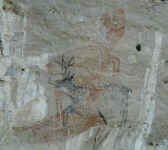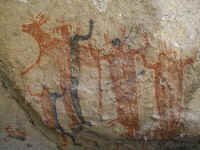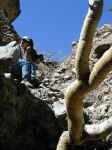Three Day Rock Art Adventure
February 21
At the moment I am exhausted, but good exhausted. We have started our adventure into the canyons of the Sierra de San Francisco to visit the famous rock art sites.
We began our day at 8AM by meeting Carlo, our guide, at his home. He had saddled 3 mules for riding and packed our supplies onto 2 burros. He even brought along a spare burro. A spare burro?
At about 9:30 we were off. We started out across the top of a mesa and just before the descent into the canyon stopped to look at the magnificent view. Uncluttered by buildings or any other man-made items, the view was endless.

Then it was time to descend. The descent into the canyon is steep and the trail is not maintained at all. The mules and burros have blazed the trail over years of use, but it is full of rocks, loose gravel and in places is just slickrock. The mules are very sure footed however and they carefully picked their way down. Some of the step-downs off of rocks however were a long way down. My "oomph!" at the end of each one probably echoed across the canyon. Our mantra soon became "trust the mules". And after a while the movements of the mule became a second nature feeling. As long as you didn't look down!
We reached our camp at Rancho Santa Teresa after four hours of seeming torture. Just getting off the mules was a blessing. But after setting up camp and having lunch, we were ready to hike to see our first cave paintings. Above our camp was Cueva Santa Teresa I, or La Palma as Carlo called it.
It was a difficult, steep hike in hot sun, but the pictures on the exposed wall were worth it.
| Overlapping pictures of humans (called monos) and overlapping views of deer and other animals were visible though weathered because of exposure. Researchers don't know why the painters overlapped the figures but the effect is very interesting. |  |
I imagine we'll sleep well tonight and tomorrow we'll see the premier cave, Cueva Pintada as well as a couple of others.
February 22
This adventure is definitely not for the faint-hearted. Many times during the day I have had to tell myself not to look down. Our guide Carlo has lived his entire 28 years in Rancho San Francisco and in these mountains. Being raised here has given him the physical advantage of being nearly as surefooted as his mules. He can walk over the uneven ground without even looking down. I have to look at every spot I place my feet! The painted caves and overhangs are located anywhere from 150-250 ft above the canyon floor and the trails that exist are not maintained and are little more than animal trails and Carlo just about runs up cliff side.
Today we visited three caves, Soledad, Flechas and Pintada. We started with an hour and a half scramble over the boulders in the stream bed before reaching Soledad Canyon.
At this point Carlo decided that the trail to the cave was straight up - so that's where we went, for the next 100 feet.
Cueva de Soledad, named after the canyon in which it is located, has several impressive monos and animal figures painted in the same overlapping style of superimposed layers as discussed earlier. The main features are a pair of nearly identical black birds, one of which is painted with an arrow in it. The other feature is a relatively rare example of geometric designs.
|
|
Then we moved on to our next stop, Cueva Pintada (Painted Cave). After more climbing and descending we reached this fabulous cave. "Re-discovered" in 1962 by Stanley Gardener (of Perry Mason fame) this cave runs for 500 feet along the cliff face and has paintings along its entire length! |
There are several groupings of figures and over 40 other overlapping paintings. To quote Harry Crosby who has completed the most comprehensive study of the paintings to date, this cave is "the most painted place in the most painted part of the entire range of the Great Murals."
The Cochimi Indians who lived in this area after the painters, believed the murals were painted by giants because of the size of the pictures and how high on the walls and overhangs they are. So little is known about these people that we may never know how they accomplished this feat.
| Our lunch stop and the last cave we are to visit is Cueva de las Flechas or cave of the arrows. This cave takes its name from the rare depiction of monos (human figures) impaled with arrows and/or spears. Crosby refers to these figures as "elegant" and they are absolutely beautiful and impressive. |  |
Having given our legs a bit of time to recover from all the climbing, we headed back down the canyon, over the boulders and back to camp.
February 23
The climb out of the canyon this morning was to begin before the sun came up and before the heat of the day descended. Our mischievous mules however, had other ideas. During the night they had decided to make a break for it. It took Carlo about an hour to round them up. After saddling them, packing the mules and eating breakfast, we were finally ready to go.
We were so sore from the previous two days of riding and hiking that we loaded up on aspirin for the ride out. It really helped too! The ride up and out of the canyon was beautiful and relatively pain-free. The movement of the mules going up was much less pounding also on the body than was the descent. We were actually able to appreciate some of our surroundings.
There was one spot however that was too steep even for the mules. So we dismounted and crawled over the slickrock leading the mules. Safely on the other side, we remounted and continued up. The ascent took only 3 hours as opposed to the 4 hours it took to go down. Most of it took place in the shadow of the canyon so it was definitely cooler, too. When we reached the top and the full force of the sun hit us, the temperature rose considerably.
Reaching the pueblo of San Francisco was cause for celebration. We had completed this adventure (one of our most difficult) very successfully.
Our appreciation for the beauty of the canyon, the amazing artistry of the murals and the ability of our mules and burros was enhanced by the difficulty of the journey. It also gave us a greater appreciation of what the original painters accomplished with far less equipment and help than we had.
Be sure to look at the photos and panoramas of the Great Murals.
